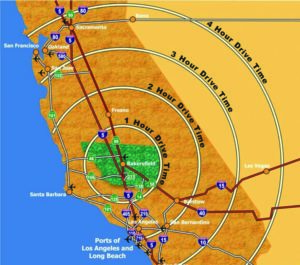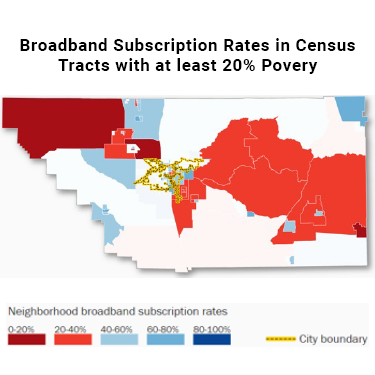B3K Prosperity’s model for inclusive economic development is focused on five drivers of economic competitiveness: traded sectors, talent, innovation, infrastructure and governance. If we want to see our region compete for investment and attract more Good and Promising Jobs, we have to prioritize action across all five drivers.
This includes considering how existing infrastructure and plans for future development contribute to the growth of Opportunity Industries and enable workers to access Quality Jobs.
How Infrastructure Drives Regional Prosperity
Infrastructure includes the basic systems and services that a country, organization, or region needs in order to function properly. That includes transportation – like roads, highways, bridges, rail, ports and airports – communication networks, water and sewer systems, power generation, utility grids, flood control, water storage and more.
Investments in infrastructure can be costly. At the same time, they are absolutely vital to economic development and prosperity, especially for a region as geographically large as Kern County. Prioritizing infrastructure investments sets the stage for industries and firms to grow and expand access to prosperity.
In our Market Assessment, we looked at how our existing transportation infrastructure and land use policies present both opportunities and challenges for the Bakersfield-Kern region. We also considered how job proximity – the distance workers travel to find employment – and broadband connectivity impact residents.
If we want to achieve our goal of improving the economic standing and quality of life for our residents, we must consider how to leverage infrastructure investments that grow regional productivity, expand access to workforce talent and promote business clusters.
Transportation and Land Use: Identifying Challenges and Opportunities to Economic Growth
The Bakersfield-Kern region faces a high number of challenges across all five drivers of economic competitiveness. This includes infrastructure. Some challenges are bound to exist in a region as large as Kern County. The county’s geography encompasses 8,000 square miles and features several distinct subregions.
At the same time, the county’s physical location, accessibility of land and active developers, good enabling infrastructure and efficient regulatory processes have contributed to the region’s economic growth in the past.
Much of the region’s economic development focus in recent years has been on the logistics industry. This has resulted in a wave of ribbon cuttings for major new warehouse facilities, bringing companies like Amazon and L’Oreal to the region.
Our adjacency to Los Angeles and proximity to other major population centers, combined with availability of land, active developers and enabling infrastructure like highways and rail have proven a boon for attracting logistics and large-scale distribution centers, especially as development slowed in other logistics hubs like the Inland Empire.
Further, the County’s streamlined process for issuing permits is cited by stakeholders as a key contributor to the region’s competitiveness. In a state like California, speedy permitting processes and a generally business-friendly climate are significant benefits of the region.
Specifically, the County has proven itself willing and able to successfully certify California Environmental Quality Act (CEQA) Environmental Impact Reports (EIR), demonstrating a proactive approach to easing development. This is especially relevant when comparing the region’s CEQA activities vis a vis our neighbors like Los Angeles, Ventura, Fresno and San Bernardino counties.

Placemaking presents challenges in East Kern
B3K has identified aerospace as an opportunity industry for the region. While we work to grow the Bakersfield-Kern region’s aerospace industry, anchored in East Kern, we also have to defend it against competition from other neighboring regions.
We found that placemaking issues like a lack of new housing and amenities, specifically in the East Kern area, pose significant disadvantages to attracting and retaining the talent necessary to serve the aerospace industry. Moreover, perceptions among local residents of an uneven level of support and investment across areas that fundamentally differ in economic composition have challenged regional institutions serving Kern County.
Job Proximity and Employment Outcomes
Job proximity is a critical factor that impacts workers’ ability to access Quality Jobs. Workers who live near Quality Jobs have a better chance of achieving upward mobility.
There is a direct correlation between job proximity and employment outcomes, especially for poor, black, female and older individuals. Distance from jobs imposes costs associated with transportation, heavily impacting lower-income workers.
Our analysis of physical job accessibility revealed mixed results between 2007 and 2017. Overall, job proximity in the Bakersfield-Kern region has declined, with our median commute distance increasing from 5.6 miles to 8.7 miles.
As we look to the future, promoting the development of sub-regional job hubs is both a highly beneficial and practical strategy for us to consider.
Stark Divisions in Broadband Subscription Rates
Kern County has extremely high broadband availability. Only 4 percent of residents lack available coverage. However, the coverage gaps that do exist overlap with high-poverty, less-populated census tracts. Broadband subscription levels are lowest in census tracts with at least 20 percent poverty, which also happen to have an above-average share of children.
Promoting equitable broadband access is important to ensuring that all residents in the Bakersfield-Kern region connect with information and resources that help them pursue opportunities for upward mobility.

Building for a more prosperous and inclusive future
Infrastructure may be the driver of economic competitiveness where the Bakersfield-Kern region is strongest. The region’s foundational infrastructure is stable, and our history of promoting significant land development projects demonstrates a pro-growth mindset.
Looking to the future, prioritizing traded sectors, promoting economic corridors and developing additional housing around more compact job hubs near existing population centers are factors that will help even out the access to opportunity.
The Bakersfield-Kern region has the potential to achieve inclusive economic growth with a continued focus on infrastructure improvements.
For more information about why infrastructure matters, download the full Market Assessment.